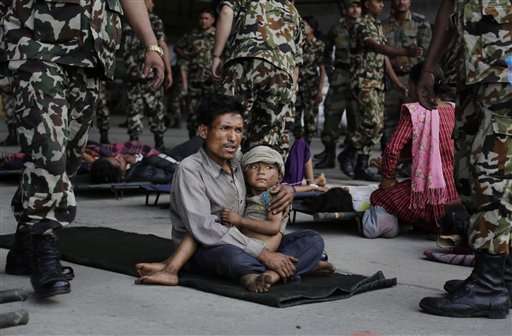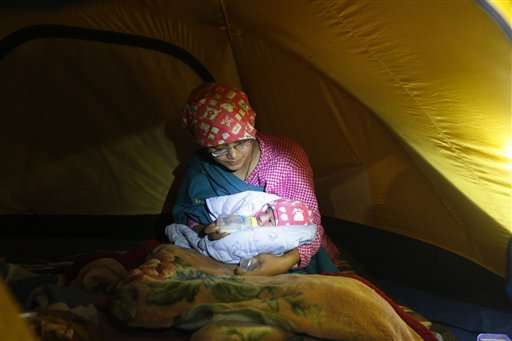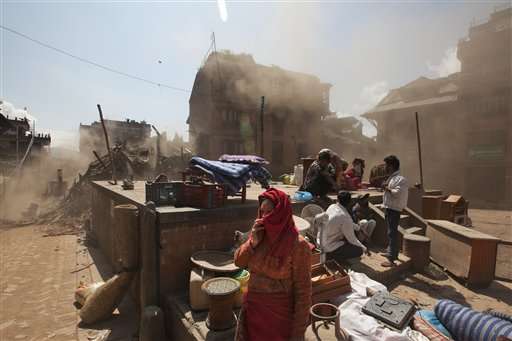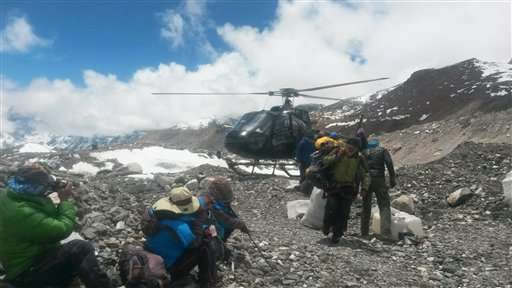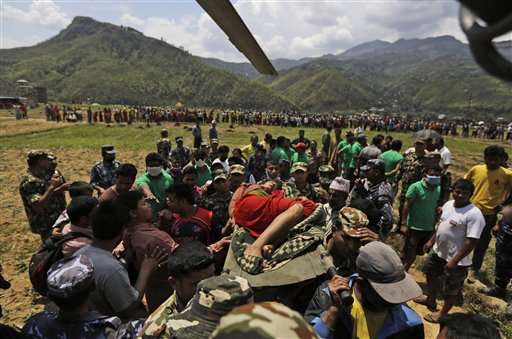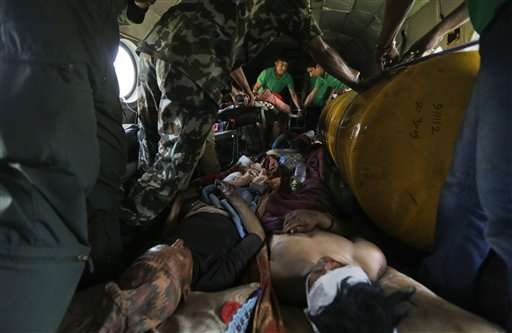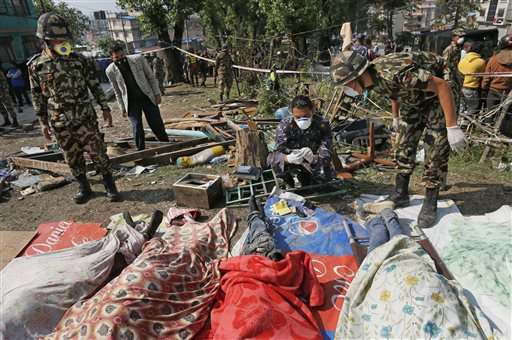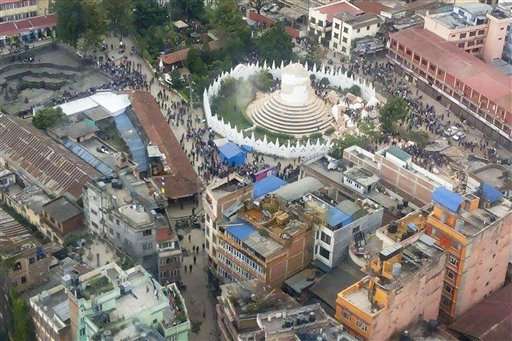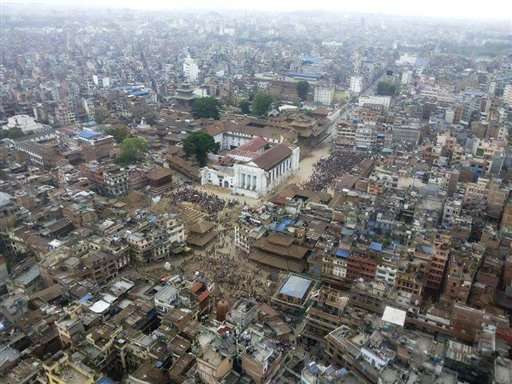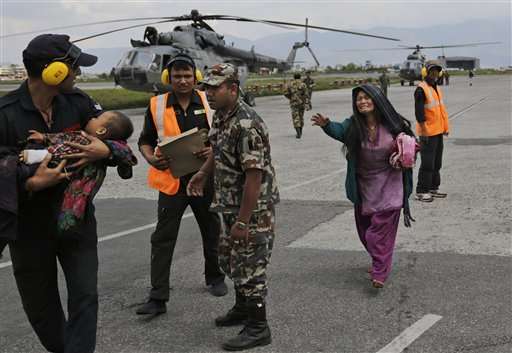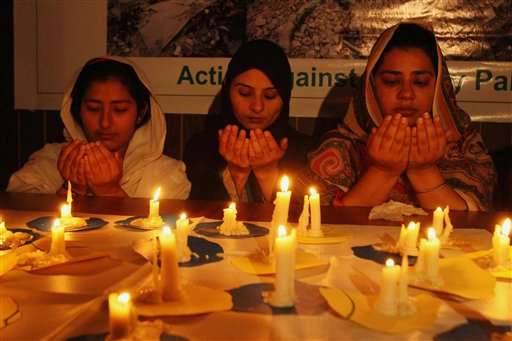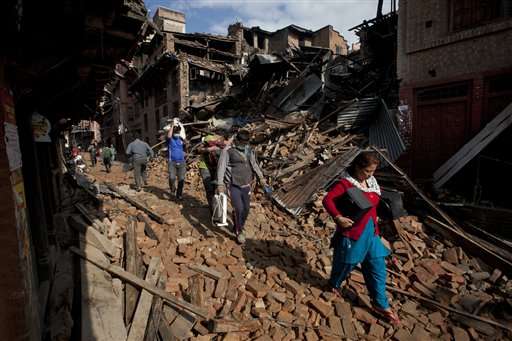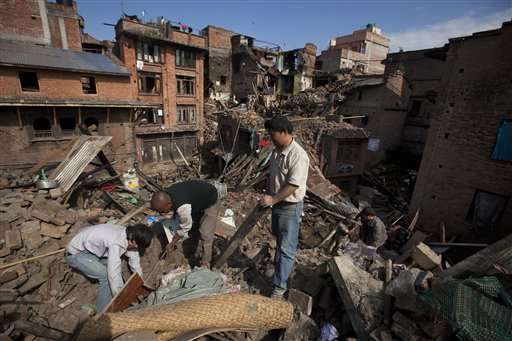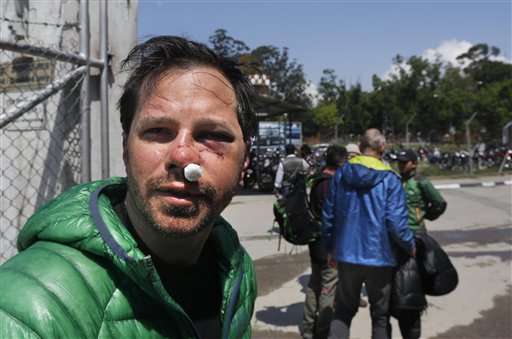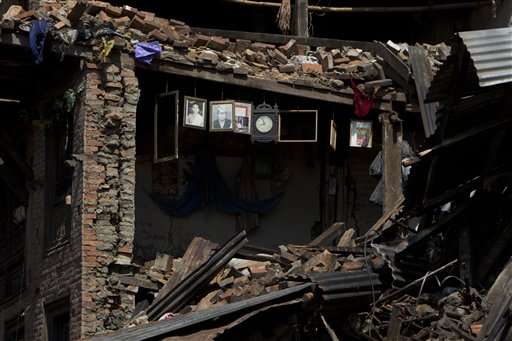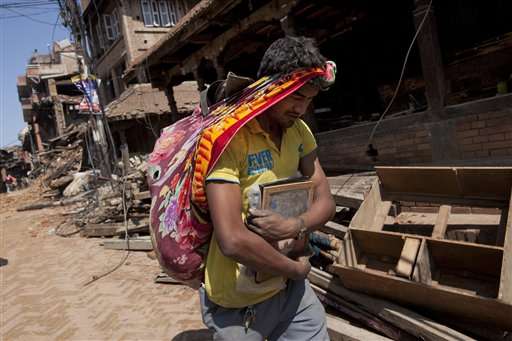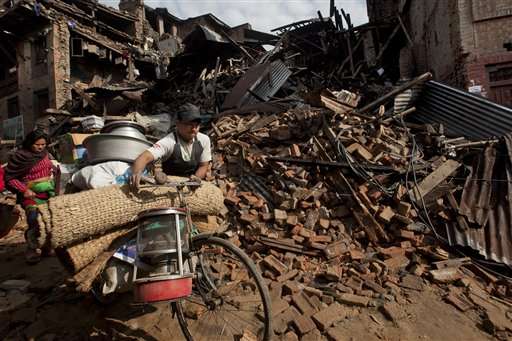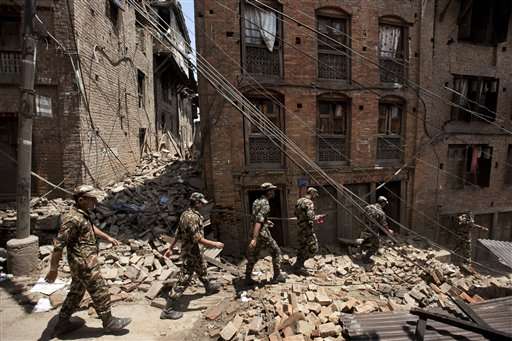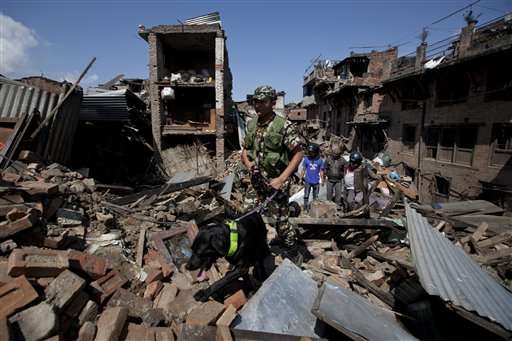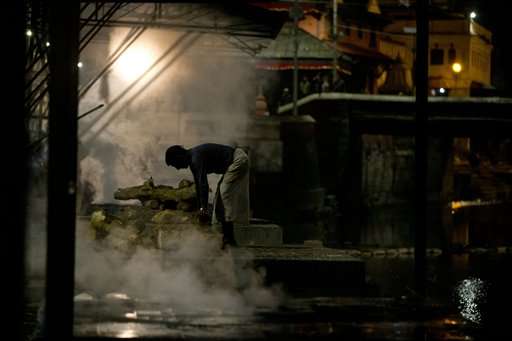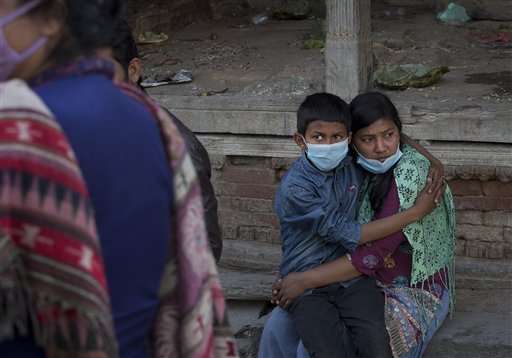A man sits with a child on his lap as victims of Saturday's earthquake, wait for ambulances after being evacuated at the airport in Kathmandu, Nepal, Monday, April 27, 2015. The death toll from Nepal's earthquake is expected to rise depended largely on the condition of vulnerable mountain villages that rescue workers were still struggling to reach two days after the disaster. (AP Photo/Altaf Qadri)
As the death toll from Nepal's devastating earthquake climbed past 4,000, aid workers and officials in remote, shattered villages near the epicenter pleaded Monday for food, shelter and medicine.
Help poured in after Saturday's magnitude-7.8 quake, with countries large and small sending medical and rescue teams, aircraft and basic supplies. The small airport in the capital of Kathmandu was congested and chaotic, with some flights forced to turn back early in the day.
Buildings in parts of the city were reduced to rubble, and there were shortages of food, fuel, electricity and shelter. As bodies were recovered, relatives cremated the dead along the Bagmati River, and at least a dozen pyres burned late into the night.
Conditions were far worse in the countryside, with rescue workers still struggling to reach mountain villages two days after the earthquake.
Some roads and trails to the Gorkha district, where the quake was centered, were blocked by landslides—but also by traffic jams that regularly clog the route north of Kathmandu.
"There are people who are not getting food and shelter. I've had reports of villages where 70 percent of the houses have been destroyed," said Udav Prashad Timalsina, the top official for the Gorkha region.
World Vision aid worker Matt Darvas arrived in the district in the afternoon and said almost no assistance had reached there ahead of him.
Newer concrete buildings were intact, Darvas said, but some villages were reported to be devastated. He cited a "disturbing" report from the village of Singla, where up to 75 percent of the buildings may have collapsed and there has been no contact since Saturday night.
In the villages that have been reached, World Vision said the greatest needs were for search-and-rescue teams, food, blankets, tarps and medical treatment.
Timalsina said 223 people had been confirmed dead in Gorkha district but he presumed "the number would go up because there are thousands who are injured."
He said his district had not received enough help from the central government, but Jagdish Pokhrel, a clearly exhausted army spokesman, said nearly the entire 100,000-soldier army was involved in rescue operations.
"We have 90 percent of the army out there working on search and rescue," he said. "We are focusing our efforts on that, on saving lives."
Nepal's Home Ministry said the country's death toll had risen to 4,010. Another 61 were killed in neighboring India, and China's official Xinhua News Agency reported 25 dead in Tibet. At least 18 of the dead were killed at Mount Everest as the quake unleashed an avalanche that buried part of the base camp packed with foreign climbers preparing to make their summit attempts.
At least 7,180 people were injured in the quake, police said. Tens of thousands are estimated to be left homeless.
Prabina Mainali, feeds her newly born baby boy - not even a day old - in a make-shift tent situated in open ground from fear of earthquake tremors, in Kathmandu, Nepal, Monday, April 27, 2015. A strong magnitude earthquake shook Nepal's capital and the densely populated Kathmandu valley on Saturday devastating the region and leaving tens of thousands shell-shocked and sleeping in streets (AP Photo / Manish Swarup)
Rescue workers and medical teams from at least a dozen countries were helping police and army troops in Kathmandu and surrounding areas, said Maj. Gen. Binod Basnyat, a Nepal army spokesman. Contributions came from large countries like India and China—but also from Nepal's tiny Himalayan neighbor of Bhutan, which dispatched a medical team.
Two teams of U.S. Army Green Beret soldiers happened to be in Nepal when the quake struck, and the 26 Americans—who were training with the Nepalese army—are staying to help with search-and-relief efforts. The 11-member crew of a C-130 cargo plane that brought them also will remain to evacuate any American citizens if needed, said Col. Steve Warren, a Pentagon spokesman. A second U.S. cargo plane carrying members of a Los Angeles urban search-and-rescue team was due to arrive Tuesday, he said.
Medical and rescue teams from Russia, Japan, France, Switzerland and Singapore were expected in Kathmandu over the coming days, the Nepal army said.
"We are appealing for tents, dry goods, blankets, mattresses, and 80 different medicines that the health department is seeking that we desperately need now," said Lila Mani Poudyal, Nepal's chief secretary and rescue coordinator. "We don't have the helicopters that we need or the expertise to rescue the people trapped."
As people are pulled from the wreckage, he said, even more help is needed, including orthopedic doctors, nerve specialists, surgeons and paramedics.
"We are appealing to foreign governments to send these specialized and smart teams," Poudyal added.
Well over 1,000 of the victims were in Kathmandu, where security forces and Indian rescue teams continued to recover the dead. In the course of an hour Monday morning, seven were pulled from a collapsed three-story building. At another site, the body of a 12-year-old girl was found.
Acrid, white smoke rose above the Pashuputi Nath Temple. "I've watched hundreds of bodies burn," said Rajendra Dhungana, 34, who spent Sunday with his niece's family for her cremation at the temple, Nepal's most revered.
The earthquake destroyed swaths of the oldest neighborhoods in the capital, largely a collection of small, poorly constructed brick apartment buildings. Many people were surprised by how few modern structures had collapsed.
Some pharmacies and shops opened Monday, and bakeries began offering fresh bread. Huge lines of people desperate for fuel appeared outside gasoline pumps. At one station, dozens sat waiting on motorcycles.
Power seemed to have been largely restored Monday night, with streetlights blazing on major roads and lights illuminating closed shops. Things looked normal—except for the many tents pitched everywhere, including on traffic circles.
Nepalese residents gather in an open space at the site of destruction caused after Saturday's earthquake in Bhaktapur, on the outskirts of Kathmandu, Nepal, Monday, April 27, 2015. A strong magnitude earthquake shook Nepal's capital and the densely populated Kathmandu valley on Saturday devastating the region and leaving tens of thousands shell-shocked and sleeping in streets. (AP Photo/Niranjan Shrestha)
Fearful of strong aftershocks, tens of thousands of families were spending a third night outdoors in parks, open squares and a golf course, bundled against the chilly Himalayan night.
Among them was Prabina Mainali, a 26-year-old teacher who gave birth to a boy earlier Monday in a Kathmandu hospital—a bit of good news in a sea of despair.
"It's hard that he can't be in his own home right now. He should be there, we should be there, but we aren't safe. We're afraid of the aftershocks," Mainali said, feeding the as-yet unnamed infant from a bottle as a half-dozen relatives cooked a meal on a gas cooker outside the tent in a grassy park.
"We're not safe at home. Here we have less to worry about," she said, adding that her house was not seriously damaged, but windows and other glass inside was shattered.
Kathmandu district chief administrator Ek Narayan Aryal said tents and water were handed out Monday at 10 locations in Kathmandu, but that aftershocks were leaving everyone jittery. The largest, on Sunday, was magnitude 6.7.
Pierre-Anne Dube, a 31-year-old from Canada, slept on the sidewalk outside a hotel. She said she had gone from the best experience of her life—a trek to Everest base camp—to the worst.
A rescue chopper lands carrying people from higher camps to Everest Base Camp, Nepal, Monday, April 27, 2015. An avalanche on Saturday, set off by the massive earthquake that struck Nepal, left more than a dozen people dead and dozens more injured. (AP Photo/Nima Namgyal Sherpa)
"We can't reach the embassy. We want to leave. We are scared. There is no food. We haven't eaten a meal since the earthquake and we don't have any news about what's going on," she said.
The quake was the worst to hit the South Asian nation in more than 80 years. It was felt across parts of India, Bangladesh, China's region of Tibet, and Pakistan. Nepal's worst recorded earthquake, in 1934, measured 8.0 and all but destroyed the cities of Kathmandu, Bhaktapur and Patan.
The quake has strained the resources of this impoverished country best known for Everest, the highest mountain in the world. The economy of Nepal, a nation of 27.8 million people south of the mountain, relies heavily on tourism, principally trekking and climbing.
-
Nepalese soldiers carry a wounded woman to a waiting Indian air force helicopter as they evacuate victims of Saturday's earthquake from Trishuli Bazar to Kathmandu airport in Nepal, Monday, April 27, 2015. The death toll from Nepal's earthquake is expected to rise depended largely on the condition of vulnerable mountain villages that rescue workers were still struggling to reach two days after the disaster. (AP Photo/Altaf Qadri)
-
Nepalese victims of Saturday's earthquake lie inside an Indian air force helicopter as they are evacuated from Trishuli Bazar to Kathmandu airport in Nepal, Monday, April 27, 2015. The death toll from Nepal's earthquake is expected to rise depended largely on the condition of vulnerable mountain villages that rescue workers were still struggling to reach two days after the disaster. (AP Photo/Altaf Qadri)
-
Rescue teams' members identify bodies dug out of the collapsed Sitapyla church in Kathmandu, Nepal, Monday, April 27, 2015. A strong magnitude 7.8 earthquake shook Nepal's capital and the densely populated Kathmandu Valley on Saturday, causing extensive damage with toppled walls and collapsed buildings. (AP Photo/Wally Santana)
-
This aerial photo provided by Shreejan Bhandari, shows the historical Dharahara Tower, a city landmark, destroyed by Saturday's earthquake in Kathmandu, Nepal, Monday, April 27, 2015. A strong magnitude earthquake shook Nepal's capital and the densely populated Kathmandu valley on Saturday devastating the region and leaving tens of thousands shell-shocked and sleeping in streets. (Shreejan Bhandari via AP) MANDATORY CREDIT
-
This aerial photo provided by Shreejan Bhandari, shows Basantapur Durbar Square, in Kathmandu, Nepal, Monday, April 27, 2015. A strong magnitude earthquake shook Nepal's capital and the densely populated Kathmandu valley on Saturday devastating the region and leaving tens of thousands shell-shocked and sleeping in streets. (Shreejan Bhandari via AP) MANDATORY CREDIT
-
An Indian Air Force person walks carrying a Nepalese child, wounded in Saturday's earthquake, to a waiting ambulance as the mother rushes to join after they were evacuated from a remote area at the airport in Kathmandu, Nepal, Monday, April 27, 2015. The death toll from Nepal's earthquake is expected to rise depended largely on the condition of vulnerable mountain villages that rescue workers were still struggling to reach two days after the disaster. (AP Photo/Altaf Qadri)
-
Pakistani girls light candles and offer prayers for Nepalese victims of Saturday's earthquake, in Multan, Pakistan, Monday, April 27, 2015. The earthquake was the worst to hit the South Asian nation in more than 80 years. It was strong enough to be felt all across parts of India, Bangladesh, China's region of Tibet and Pakistan. (AP Photo/Asim Tanveer)
-
A young girl walks with a boy over a collapsed school playground in Kathmandu, Nepal, Monday, April 27, 2015. A strong magnitude 7.8 earthquake shook Nepal's capital and the densely populated Kathmandu Valley on Saturday, causing extensive damage with toppled walls and collapsed buildings. (AP Photo/Wally Santana)
-
Nepalese residents carry belongings from their destroyed homes as they walk through debris of Saturday's earthquake, in Bhaktapur on the outskirts of Kathmandu, Nepal, Monday, April 27, 2015. A strong magnitude earthquake shook Nepal's capital and the densely populated Kathmandu valley on Saturday devastating the region and leaving tens of thousands shell-shocked and sleeping in streets. (AP Photo/Niranjan Shrestha)
-
A Nepalese family collects belongings from their home destroyed in Saturday's earthquake, in Bhaktapur on the outskirts of Kathmandu, Nepal, Monday, April 27, 2015. A strong magnitude earthquake shook Nepal's capital and the densely populated Kathmandu valley on Saturday devastating the region and leaving tens of thousands shell-shocked and sleeping in streets. (AP Photo/Niranjan Shrestha)
-
U.S. citizen Michael Churton, 38, from New York, who was injured during an avalanche resulting from Saturday's earthquake at the base camp of the mount Everest, arrives at the domestic airport in Kathmandu, Nepal, Monday, April 27, 2015. Saturday's magnitude 7.8 earthquake spread horror from Kathmandu to small villages and to the slopes of Mount Everest, triggering an avalanche that buried part of the base camp packed with foreign climbers preparing to make their summit attempts. (AP Photo / Manish Swarup)
-
Portraits and a wall clock is seen hanging on the remains of a house damaged in Saturday's earthquake in Bhaktapur, on the outskirts of Kathmandu, Nepal, Monday, April 27, 2015. A strong magnitude earthquake shook Nepal's capital and the densely populated Kathmandu valley on Saturday devastating the region and leaving tens of thousands shell-shocked and sleeping in streets. (AP Photo/Niranjan Shrestha)
-
A Nepalese man carries his belongings from earthquake debris in Bhaktapur, on the outskirts of Kathmandu, Nepal, Monday, April 27, 2015. A strong magnitude earthquake shook Nepal's capital and the densely populated Kathmandu valley on Saturday devastating the region and leaving tens of thousands shell-shocked and sleeping in streets. (AP Photo/Niranjan Shrestha)
-
People walk past damage caused by Saturday's earthquake in Bhaktapur, on the outskirts of Kathmandu, Nepal, Monday, April 27, 2015. A strong magnitude earthquake shook Nepal's capital and the densely populated Kathmandu valley on Saturday devastating the region and leaving tens of thousands shell-shocked and sleeping in streets. (AP Photo/Niranjan Shrestha)
-
Members of the Nepalese army walk through a damaged area caused by Saturday's earthquake, in Bhaktapur, on the outskirts of Kathmandu, Nepal, Monday, April 27, 2015. A strong magnitude earthquake shook Nepal's capital and the densely populated Kathmandu valley on Saturday devastating the region and leaving tens of thousands shell-shocked and sleeping in streets. (AP Photo/Niranjan Shrestha)
-
A rescue team with a sniffer dog walks at the site of destruction caused by Saturday's earthquake in Bhaktapur, on the outskirts of Kathmandu, Nepal, Monday, April 27, 2015. A strong magnitude earthquake shook Nepal's capital and the densely populated Kathmandu valley on Saturday devastating the region and leaving tens of thousands shell-shocked and sleeping in streets. (AP Photo/Niranjan Shrestha)
-
A Nepalese priest prepares the platform for a pyre for people killed in Saturday's earthquake, at the Pashupatinath temple, on the banks of Bagmati river, in Kathmandu,Nepal, Monday, April 27, 2015. A strong magnitude earthquake shook Nepal's capital and the densely populated Kathmandu valley on Saturday devastating the region and leaving tens of thousands shell-shocked and sleeping in streets (AP Photo / Manish Swarup)
-
Monika Basnet, 15, right, holds her brother Munal Basnet, 10, during the cremation of their father killed in Saturday's earthquake, at the Pashupatinath temple, on the banks of Bagmati river, in Kathmandu, Nepal, Monday, April 27, 2015. A strong magnitude earthquake shook Nepal's capital and the densely populated Kathmandu valley on Saturday devastating the region and leaving tens of thousands shell-shocked and sleeping in streets (AP Photo / Manish Swarup)
© 2015 The Associated Press. All rights reserved.
